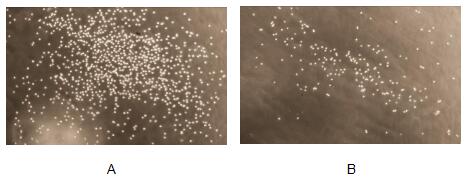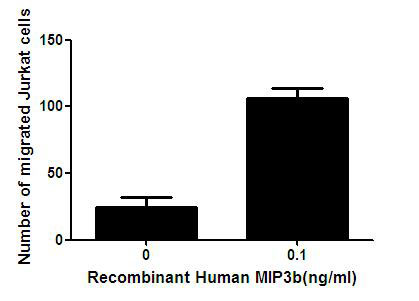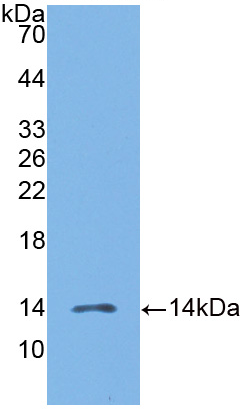Active Macrophage Inflammatory Protein 3 Beta (MIP3b) 

CCL19; CKb11; ELC; MIP3-B; SCYA19; Chemokine C-C-Motif Ligand 19; Beta Chemokine Exodus-3; CK Beta-11; EBI1-Ligand Chemokine; Small Inducible Cytokine Subfamily A19
- UOM
- FOB US$ 211.00 US$ 528.00 US$ 1,056.00 US$ 3,168.00 US$ 7,920.00
- Quantity
Overview
Properties
- Product No.APA096Hu01
- Organism SpeciesHomo sapiens (Human) Same name, Different species.
- ApplicationsCell culture; Activity Assays.
Research use only - DownloadInstruction Manual
- CategoryCytokineInfection immunity
- Buffer Formulation20mM Tris, 150mM NaCl, pH8.0, containing 1mM EDTA, 1mM DTT, 0.01% SKL, 5% Trehalose and Proclin300.
- Traits Freeze-dried powder, Purity > 97%
- Isoelectric Point9.6
Sign into your account
Share a new citation as an author
Upload your experimental result
Review

Contact us
Please fill in the blank.
Activity test

Macrophage Inflammatory Protein 3 Beta (MIP3b) is a small cytokine belonging to the CC chemokine family that is also known as EBI1 ligand chemokine (ELC) and Chemokine C-C motif ligand 19 (CCL19). This chemokine elicits its effects on its target cells by binding to the chemokine receptor chemokine receptor CCR7. It attracts certain cells of the immune system, including dendritic cells and antigen-engaged B cells, CCR7 central-memory T-Cells. Thus, chemotaxis assay used 24-well microchemotaxis system was undertaken to detect the chemotactic effect of recombinant human MIP3b on the Jurkat cell line. Briefly, Jurkat cells were seeded into the upper chambers (150μL cell suspension,106 cells/mL in RPMI 1640 with FBS free) and MIP3b (0.01ng/mL, 0.1ng/mL, 1ng/mL, 10ng/mL, 100ng/mL and 1000ng/mL diluted separately in serum free RPMI 1640) was added in lower chamber with a polycarbonate filter (8μm pore size) used to separate the two compartments. After incubation at 37℃ with 5% CO2 for 3h, the filter was removed, then cells in low chamber were observed by inverted microscope at low magnification (×100) and the number of migrated cells were counted at high magnification (×400) randomly (five fields for each filter). Result shows MIP3b is able to induce migration of Jurkat cells. The migrated Jurkat cells in low chamber at low magnification (×100) were shown in Figure 1. Five fields of each chamber were randomly chosen, and the migrated cells were counted at high magnification (×400). Statistical results were shown in Figure 2. The optimum chemotaxis of recombinant human MIP3b occurs at 0.1-1ng/mL.
(A) Jurkat cells were seeded into the upper chambers and serum free RPMI 1640 with 0.1ng/mL MIP3b was added in lower chamber, then cells in lower chamber were observed at low magnification (×100) after incubation for 3h;
(B) Jurkat cells were seeded into the upper chambers and serum free RPMI 1640 without MIP3b was added in lower chamber, then cells in lower chamber were observed at low magnification (×100) after incubation for 3h.
Figure. The chemotactic effect of recombinant human MIP3b on Jurkat cells.

Figure. The chemotactic effect of recombinant human MIP3b on Jurkat cells.
Usage
Reconstitute in 20mM Tris, 150mM NaCl (PH8.0) to a concentration of 0.1-1.0 mg/mL. Do not vortex.
Storage
Avoid repeated freeze/thaw cycles. Store at 2-8°C for one month. Aliquot and store at -80°C for 12 months.
Stability
The thermal stability is described by the loss rate. The loss rate was determined by accelerated thermal degradation test, that is, incubate the protein at 37°C for 48h, and no obvious degradation and precipitation were observed. The loss rate is less than 5% within the expiration date under appropriate storage condition.
Increment services
-
 BCA Protein Quantification Kit
BCA Protein Quantification Kit
-
 Molecular Mass Marker for Protein
Molecular Mass Marker for Protein
-
 Monoclonal Antibody Customized Service
Monoclonal Antibody Customized Service
-
 Polyclonal Antibody Customized Service
Polyclonal Antibody Customized Service
-
 Protein Activity Test Experiment Service
Protein Activity Test Experiment Service
-
 Electrophoretic Mobility Shift Assay (EMSA) Experiment Service
Electrophoretic Mobility Shift Assay (EMSA) Experiment Service
-
 Buffer
Buffer
-
 Lentivirus Packaging Experiment Service
Lentivirus Packaging Experiment Service
-
 Adenovirus Packaging Experiment Service
Adenovirus Packaging Experiment Service
-
 Real Time PCR Experimental Service
Real Time PCR Experimental Service
-
 Spike RBD Protein (S-RBD)
Spike RBD Protein (S-RBD)
-
 Protein G
Protein G
-
 Protein A
Protein A
Citations
- MIP-3beta/CCL19 is associated with the intrathecal invasion of mononuclear cells in neuroinflammatory and non-neuroinflammatory CNS diseases in dogsPubmed:25016392
- Plasma inflammatory biomarkers for Huntington’s disease patients and mouse model Pubmed:25266150
- Plasma inflammatory biomarkers for Huntington’s disease patients and mouse modelPubMed: 25266150
- 类风湿关节炎血清中CCL19 和CCL21 的表达水平与肺间质病变的关系:








